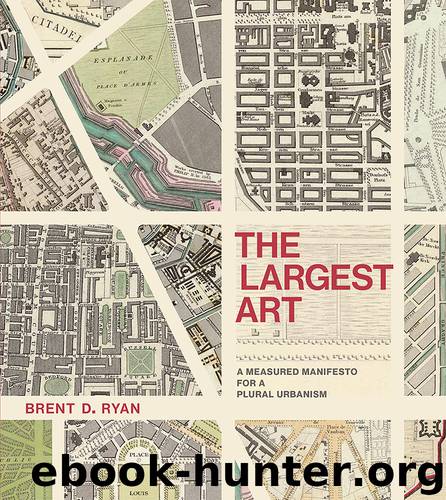The Largest Art by Brent D. Ryan

Author:Brent D. Ryan
Language: eng
Format: epub
Publisher: The Massachusetts Institute of Technology
Published: 2017-11-09T05:00:00+00:00
4.12 Paris contains a number of interlinked axes and spaces organized by monumental structures. Bacon found this type of “design structure” to be spectacular, but also too costly and time-consuming to be applied in the more economical context of American cities.
Bacon believed in the importance of a designer’s will, but by 1967 he had also operated for almost thirty years within the rough-and-tumble world of municipal politics and, at a larger scale, within the democratic setting of American society. Bacon was no dreamer wishing for the power of Louis XIV, though we will see that he was not averse to the urbanism that could be created under such autocratic circumstances. Thus Bacon did not merely acknowledge the necessity of involving a democratic public, he personally advocated it. As he notes, the “safeguards and processes of rejection” of contemporary politics makes any “forc[ing of a designer’s] ideas on a community [and] overriding the sentiment of the community extremely unlikely.” 47With the lessons of Philadelphia in mind, Bacon emphasized that only the designer operating within and with a plural public could achieve success.
With involvement firmly established as a baseline condition under which urban design need occur, Bacon proceeds to develop his “movement system” as a guiding concept. Bacon disowned cities designed by the static method of the plan view, arguing instead that movement through space alone permitted pedestrians (and other types of urban travelers) to perceive the larger design within which they exist. 48Bacon explicitly criticized plan-centric designs such as Vällingby (Sweden), Chandigarh, and Brasília, though Brasília’s all-uniting sky did, Bacon believed, excuse it to some extent. Movement systems were necessary in contemporary urban design because the scale of modernist development had broken the traditional tie between a plan view and human experience. Whereas Renaissance urban spaces such as Italy’s Pienza or the Campidoglio in Rome were small enough to be entirely perceptible from a static viewpoint, such understanding was impossible within the vast scale of the contemporary city. At the same time, Bacon noted, extending design ideas over a larger geographical space than in the Renaissance necessitated a certain economy: movement systems marked by individual elements at intervals “enabl[ed] the designer to establish a central design structure without attempting to cover the entire area.” Thus movement systems, in Bacon’s eyes, answered urban designers’ needs to shape contemporary cities in a manner that was visually and experientially perceptible, as well as realizable, economical, durable, and democratically acceptable.
Download
This site does not store any files on its server. We only index and link to content provided by other sites. Please contact the content providers to delete copyright contents if any and email us, we'll remove relevant links or contents immediately.
Kathy Andrews Collection by Kathy Andrews(11345)
The remains of the day by Kazuo Ishiguro(8419)
Paper Towns by Green John(4815)
Spare by Prince Harry The Duke of Sussex(4807)
Industrial Automation from Scratch: A hands-on guide to using sensors, actuators, PLCs, HMIs, and SCADA to automate industrial processes by Olushola Akande(4636)
The Body: A Guide for Occupants by Bill Bryson(4603)
Machine Learning at Scale with H2O by Gregory Keys | David Whiting(3671)
Be in a Treehouse by Pete Nelson(3655)
Harry Potter and the Goblet Of Fire by J.K. Rowling(3620)
Never by Ken Follett(3551)
Goodbye Paradise(3464)
The Remains of the Day by Kazuo Ishiguro(3148)
Into Thin Air by Jon Krakauer(3138)
The Cellar by Natasha Preston(3081)
The Genius of Japanese Carpentry by Azby Brown(3045)
Fairy Tale by Stephen King(2977)
120 Days of Sodom by Marquis de Sade(2947)
Drawing Shortcuts: Developing Quick Drawing Skills Using Today's Technology by Leggitt Jim(2943)
The Man Who Died Twice by Richard Osman(2824)
